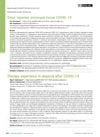Search
for
Sort by
Research
510-540 / 1000+ results
research Prolactin and the Skin: A Dermatological Perspective on an Ancient Pleiotropic Peptide Hormone
Prolactin affects hair growth and skin conditions, and could be a target for new skin disease treatments.

research A 12-Week Treatment with the Long-Acting Glucagon-Like Peptide 1 Receptor Agonist Liraglutide Leads to Significant Weight Loss in a Subset of Obese Women with Newly Diagnosed Polycystic Ovary Syndrome
Liraglutide caused significant weight loss in some obese women with PCOS, especially those with severe obesity and insulin resistance.

research An Androgenetic Alopecia Remedy Based on Marine Collagen Peptide-Incorporated Dissolving Microneedles
New hair loss treatment using marine collagen and dissolvable needles improves hair growth.
research Hair-Growth-Promoting Effects of the Fish Collagen Peptide in Human Dermal Papilla Cells and C57BL/6 Mice Modulating Wnt/Beta-Catenin and BMP Signaling Pathways
Fish collagen peptides can significantly promote hair growth.

research Urticaria Neonatorum: Accumulation of Tryptase-Expressing Mast Cells in the Skin Lesions of Newborns with Erythema Toxicum
Newborns with the common rash Erythema Toxicum have many active mast cells in their skin, but these cells don't produce the LL-37 peptide.

research Hair Loss During Menopause: Solutions to the Problem
Selenzin Peptide Active can effectively treat hair loss in postmenopausal women.

research Clinical Snippets: Hair Growth, Androgenetic Alopecia, Psoriasis, Hidradenitis Suppurativa, and Alopecia Areata
R-spondin2 may help treat hair loss, gene differences could explain baldness, a peptide's regulation is linked to psoriasis, B-defensin gene copies may affect a skin condition's risk and severity, and potential markers and targets for alopecia areata were identified.

research Insights on the Mechanical Behavior of Keratin Fibrils
Keratin's mechanical properties are influenced by hydrogen bonds and secondary structure, and can be improved with the SPD-2 peptide.

research Discovery of a Transdermally Deliverable Pentapeptide for Activating AdipoR1 to Promote Hair Growth
A new small peptide may help hair growth by activating a specific receptor and should be tested in humans.

research A Novel Tetrapeptide for the Treatment of Hair Loss Identified in Ginseng Berry: In Silico Characterization and Molecular Docking with TGF-β2
A new peptide from ginseng berries may help prevent hair loss by promoting cell growth and reducing stress damage.

research Sequence-Structure Based Phylogeny of GPCR Class A Rhodopsin Receptors
The research found how GPCR Class A Rhodopsin receptors are related and suggested possible substances they interact with.

research Minoxidil May Suppress Androgen Receptor-Related Functions
Minoxidil can reduce functions related to androgen receptors.

research Gender Differences in Skin Aging and the Changing Profile of the Sex Hormones with Age
The document concludes that there are still unknowns about the effectiveness, risks, and detection of performance-enhancing drugs, and doping remains a challenge.

research Estrogen-Dependent Development of Sex Differences in Somatostatin Neurons of the Hypothalamic Periventricular Nucleus
Male rats have more somatostatin neurons than females due to testosterone converting to estrogen during early development.

research The Negative Regulator CXXC5: Making WNT Look a Little Less Disheveled
CXXC5 is a protein that prevents hair growth and could be a target for hair loss treatment.

research A Sharply Marginated Erythematous Dermatitis in a Toddler
A toddler with a rash and developmental delays improved after treatment for severe malnutrition caused by a diet lacking in protein.

research Water Distribution in Human Hair Microstructure Elucidated by Spin Contrast Variation Small-Angle Neutron Scattering
The technique showed that human hair has two main parts, with 68% being rigid and the rest flexible, and water swelling affects its structure.
research Porphyrinoid Photosensitizers for Targeted and Precise Photodynamic Therapy: Progress in Fabrication
Targeted photodynamic therapy is a promising method for precise disease treatment and diagnosis.

research Therapy Experience in Alopecia After COVID-19
The treatment with an oral drug and topical lotion is effective and well-tolerated for hair loss after COVID-19.
research Pathway Enrichment and Network Analysis of Differentially Expressed Genes in Pashmina Goat
The analysis found genes linked to skin and hair development are more active in Pashmina goats, which may explain their long-fiber production.

research The 39th Manfred Donike Workshop on Doping Analysis
The 39th Manfred Donike Workshop discussed methods for detecting misuse of steroids, gene doping, and the complexity of identifying drug residues in urine, highlighting the ongoing efforts to improve global anti-doping work.
research Uptake and Utilization of Amino Acids by Human Hair Follicles and Related Cells
Cysteine and arginine are essential for hair growth and thickness.
research Mechanism of Laccase-Assisted Tyrosine Grafting on Keratin Using BSA as a Model Protein
New hair perming method using tyrosine is gentler and can be done with a blow-dryer.

research Expression of Nidogen1 in Basal Cell Carcinoma
Higher levels of nidogen1 and type IV collagen are found in basal cell carcinoma compared to normal skin.

research Book Reviews
Maintaining anticoagulation is crucial for patients with antiphospholipid syndrome.

research Proteins Observed in Scalp Hair from Preschool Children
Mothers have more hair proteins than their children, with age-related differences in protein patterns, and some proteins in hair could indicate early childhood development.
research Computer-Assisted Epitope Prediction Revealed Potential Autoantigens Associated with Human Alopecia Areata
Melanogenesis-related proteins may trigger immune responses in alopecia areata patients.
research Bioactive Peptides Derived from Food Proteins Preventing Lifestyle-Related Diseases
Food-derived peptides may help prevent diseases like high blood pressure and high cholesterol, and can support the immune system.

research 17-Hydroxyprogesterone Responses to Gonadotropin-Releasing Hormone Reveal Distinct Phenotypes of Functional Ovarian Hyperandrogenism and Polycystic Ovary Syndrome
The research found that polycystic ovary syndrome (PCOS) has two distinct types, with one having more severe hormone and insulin issues.